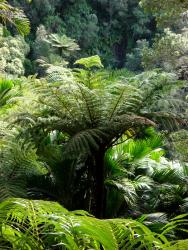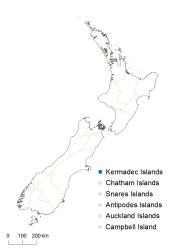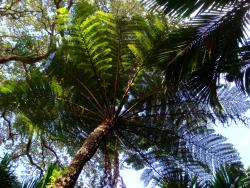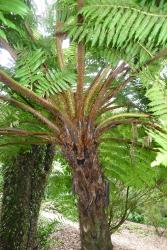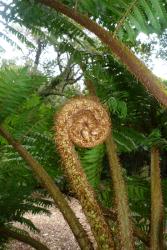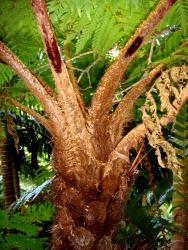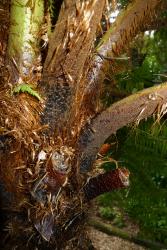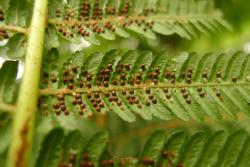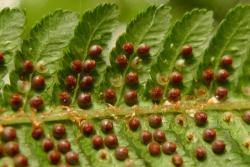- ≡ Alsophila kermadecensis (W.R.B.Oliv.) R.M.Tryon, Contr. Gray Herb. 200: 37 (1970)
Rhizomes erect, forming a woody trunk up to c. 20 m tall, 140–200 mm in diameter, covered in red-brown appressed stipe bases in the upper part of the trunk and stipe scars in the lower part; bearing scales near the apex. Rhizome scales marginate, narrowly ovate, lacking dark-coloured setae, pale brown or red-brown. Fronds 2050–4000 mm long, arching up from the crown; dead fronds often falling to leave clean scars but sometimes a few persisting on the trunks. Stipes 70–320 mm long, 10–33 mm wide and 10–30 mm deep at the base, pale brown to red-brown becoming black at the very base, tuberculate and rough, bearing hairs and scales; hairs fine, acicular, colourless or pale brown, up to 1 mm long; larger scales narrowly ovate, pale or red-brown, up to 35 mm long and 1 mm wide, densely covering base of stipe, becoming more scattered distally; smaller scales acaroid, colourless, 0.1–0.2 mm long, sometimes forming a dense appressed tomentum on young stipes. Laminae 2-pinnate-pinnatifid to 2-pinnate-pinnatisect, elliptic or obovate, 1750–2100 mm long, 700–900 mm wide, adaxial surface dark shining green, abaxial surface dull green, coriaceous to herbaceous; adaxial surfaces of rachis, pinna midribs and costae abundantly covered in fine, acicular, colourless or pale brown hairs up to 1 mm long; abaxial surfaces bearing hairs and scales; hairs acicular, scattered, irregularly curled, up to 1.5 mm long; larger scales abundant, narrowly ovate, pale brown, up to 5 mm long and 1 mm wide, usually lacking a terminal red seta; smaller scales acaroid, colourless, 0.1–0.2 mm long, sometimes with expanded bases, often appressed to costa surface; rachis yellow-brown or pale brown, finely tuberculate. Primary pinnae in 18–30 pairs, narrowly ovate or narrowly elliptic or elliptic; the longest above the middle, 325–610 mm long, 110–195 mm wide, short-stalked; the lowest pair often greatly reduced. Secondary pinnae narrowly ovate or narrowly triangular, the longest 65–115 mm long, 14–35 mm wide, short-stalked or sessile. Longest tertiary segments 8–22 mm long, 2–2.5 mm wide, adnate; apices acute; margins crenate. Sori 0.6–0.9 mm in diameter; paraphyses shorter than sporangia, or absent; indusia open on side away from costa before maturity, hood-shaped at maturity and forming more than a hemisphere, splitting on upper surface with age.
Cyathea kermadecensis is morphologically very similar to C. cunninghamii. The two taxa share indusia which open at maturity to form a hood-shape, and a diverse array of very similar hairs and scales on the abaxial surface of the laminae. No other taxa in New Zealand or Australia have indusia of this type or such a diversity of scales and hairs. However, C. kermadecensis has a greater abundance of large pale brown scales on the abaxial surfaces of the costae than C. cunninghamii, and scattered, irregularly curled, acicular hairs on the abaxial costae which are usually absent in C. cunninghamii. C. kermadecensis also lacks the red acaroid scales of C. cunninghamii, producing only colourless acaroid scales with slightly longer branches. The tertiary segments of C. cunninghamii are slightly more divided, and the stipe bases of C. kermadecensis are red-brown rather than black as in C. cunninghamii. The status of the two species has been discussed by Brownsey & Perrie (2015a). They are very closely related, but are retained here as species in the absence of any definitive evidence to the contrary.
Kermadec Islands.
Altitudinal range: 15–465 m.
Endemic to Raoul Island.
Cyathea kermadecensis grows in Metrosideros, Ascarina and Rhopalostylis forest in ravines, gullies and on cliffs, mostly in the higher and wetter parts of Raoul Island but also at lower elevations and drier sites. It is apparently less common than C. milnei (Sykes 1977).
Cyathea kermadecensis was given a conservation status of Naturally Uncommon by de Lange et al. (2013).
2n = 138 (Murray & de Lange 2013).
Cyathea kermadecensis was first lectotypified by Holttum (1964). However his choice included two specimens and was further narrowed to a single specimen by Brownsey & Perrie (2015b).



